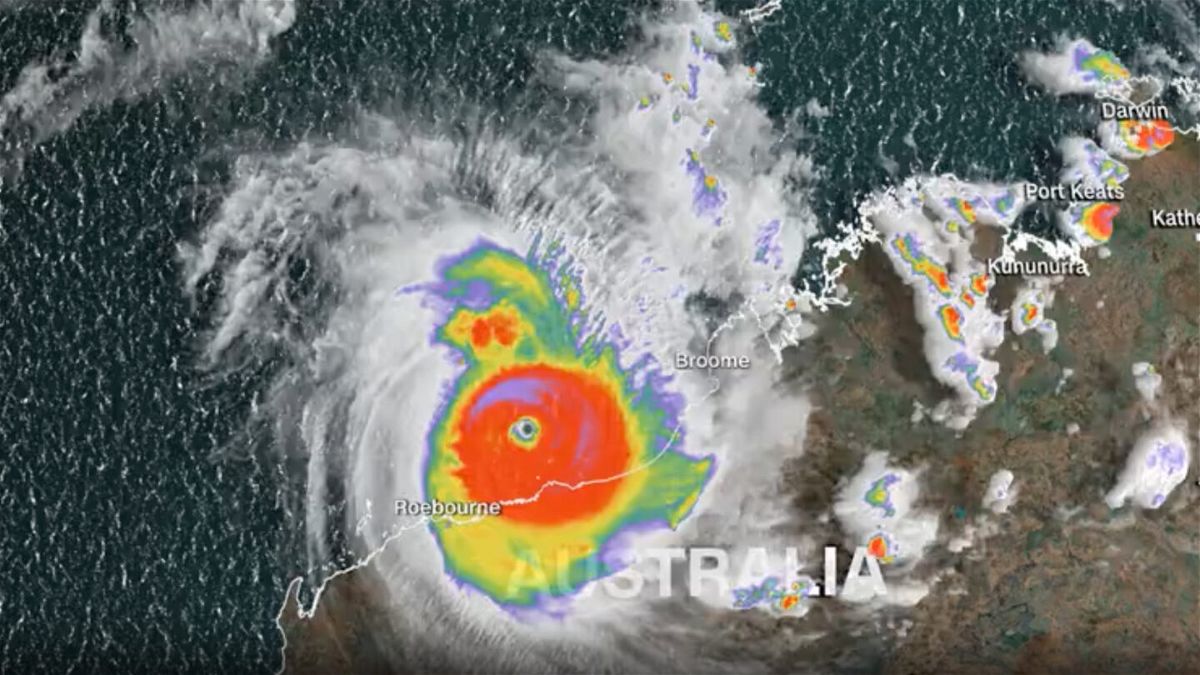Cyclone Ilsa sets a new wind record as it smashes into Australia’s western coast

Cyclone Ilsa smashed into a remote stretch of coast in Western Australia around midnight Thursday local time with wind speeds that broke previous records set more than 10 years ago in the same place.
By Hilary Whiteman, CNN
Cyclone Ilsa smashed into a remote stretch of coast in Western Australia around midnight Thursday local time with wind speeds that broke previous records set more than 10 years ago in the same place.
After brewing off the coast for days, Cyclone Ilsa made landfall between De Grey and Pardoo Roadhouse as a category 5 storm, according to Australian Bureau of Meteorology — the equivalent of a category 4 Atlantic hurricane.
The cyclone has since weakened and is moving southeast across the state, bringing heavy rain and sustained winds of 120 kilometers per hour (74 miles per hour).
Just before it hit the mainland, Ilsa sped over Bedout Island, a tiny uninhabited island, where its sustained wind speeds reached 218 kph (135 mph) over a 10-minute period.
“Cyclone George was the previous record holder with 194 kph back in 2007 at the very same location!” the BOM tweeted. Overnight, wind gusts on the island, which is a breeding ground for seabirds, reached as high as 288 kph (179 mph).
It’s not yet clear what damage the cyclone has inflicted on Western Australia, though the winds had the potential to cause significant damage to trees, buildings, power lines and other infrastructure.
Officials were planning to survey the damage from the air when it was safe enough to fly helicopters over the area.
On Friday, Superintendent Peter Sutton, of the Western Australia department of fire and emergency services, said the cyclone appears to have missed the main population centers, including the town of Port Hedland, home to about 16,000 people, mostly mine workers.
“There will certainly will be damage up along the coastal areas where the crossing occurred, but largely the populated areas did escape the brunt of the eye as it crossed the coast,” Sutton said.
Port Hedland mayor Peter Carter told the Australia Broadcasting Corporation (ABC) that the wind gusts sounded like a freight train. “I think the town was very lucky … the town is still here,” he told CNN affiliate Seven News.
Port Hedland is the world’s biggest bulk export port, where large volumes of iron ore are loaded and shipped to countries including China, Japan and South Korea. Pilbara Ports Authority said the port reopened Friday after safety inspections to check for any damage to infrastructure.
Bidyadanga, the largest Aboriginal community in the state, home to around 850 people, was also relatively unscathed, according to early reports.
Early Friday, reports emerged of “great damage” at Pardoo Roadhouse, a popular destination for travelers on the highway along the coast. One of its owners, Will Batth, told the ABC that he endured “four hours of hell” and eventually sought shelter in a shipping container while Cyclone Ilsa tore off the roof.
Authorities had warned residents to tie down anything that might take flight in strong winds — caravans, trampolines, trailers and any loose objects.
“Winds of this strength are extremely dangerous. Not only can they bring down trees, power lines, and damage roofs and houses, but they can also lift large loose objects from your yard — boats, trailers or caravans — and loft them into the air,” BOM’s senior meteorologist Miriam Bradbury warned.
As the storm approached on Thursday, coastal areas were put under a red alert, meaning people needed to stay in place and shelter within buildings, well away from windows and doors.
Evacuation centers were opened for people brought in from remote communities at risk of being pummeled by the winds and cut off by debris and flooding.
Cyclone Ilsa is expected to dump heavy rain on the region — as much as 200 to 300 millimeters, according to BOM — and vast areas of the state are under flood watch.
“Riverine flooding may significantly impact roads and access routes, with many paths becoming muddy or even inaccessible over the coming days,” Bradbury said on Thursday.
The strongest storm ever to hit any part of Australia was Cyclone Monica, which arrived in 2006 with sustained winds around 290 kph (180 mph), as it swept across the eastern and northern parts of Australia.
That cyclone missed highly populated areas but brought down trees and caused severe damage to vegetation along with a storm surge up to six meters high.
The-CNN-Wire
™ & © 2023 Cable News Network, Inc., a Warner Bros. Discovery Company. All rights reserved.
